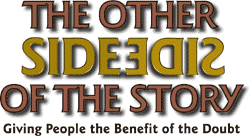Light Lines - Emor
15 Iyar 5759 / May 1, 1999 Parshat Emor
"Any man of your offspring throughout their generations in whom there be a blemish shall not come near to offer the food of G-d." (Leviticus 21:17)
The door of the restaurant swung open, letting in some of the sound and smell of Hollywood Boulevard. A short, dapper figure whose smile was fraying a little at the edges stood at the door. He looked around for a second and then started to pick his way through the restaurant; a couple of waiters, their trays held high, pirouetted neatly around him. Finding the booth I was sitting in, he slumped himself down on the opposite bench. He looked at me for a long second. I asked him "How did the audition go?" He smiled his worn smile and said "I just found out I'm too old for the parts I used to be too short for."
In Hollywood their is no dichotomy between appearance and reality - appearance is reality. The way you look is everything.
Not so with the Torah.
Which is not to say that appearance is nothing. The Torah teaches us that in a dispute between a rich man and a poor man, the judge must take the rich man aside and tell him to either dress the poor man in clothes that are the equal of his own, or to put on poor man's clothes. Only then will he judge their case. The reason is that the judge may be influenced by the status of the rich man. On the one hand he may be impressed by his status and be biased to the rich man's version of the case. Alternatively, he may feel sorry for the poor man and judge in his favor.
What is puzzling about this law is that the judge already knows that the rich man is rich and the poor man is poor. Why isn't this just a charade to get them to dress up in different clothes? After all, the judge knows exactly who he's dealing with the whole time, doesn't he?
Seeing has a power which is unique to the senses. A smell may be more evocative, a sound may be more soothing, but nothing is as immediate as a sight. Seeing, as they say, is believing. And seeing can make you believe, even when you know that what you're seeing isn't true. In our own times, we know the tremendous hold that advertising has over us, even when we know that their entire agenda is to sell more soap. The visual sneaks beneath the fences of discernment and lodges itself in the subconscious.
With this idea, maybe we can understand a puzzling aspect of this week's Parsha. The Torah prohibits a kohen (priest) who has physical defects from performing the service of the Holy Temple. These blemishes included a kohen who was blind, lame, whose nose had no bridge, who had one eye that was noticeably larger than the other, who had one shin or thigh longer than the other, a kohen who was a hunchback, had abnormally long eyebrows or had a white line extending from the white of the eye into the iris. All these were excluded from service.
If the service of G-d is a spiritual endeavor, why does the Torah exclude kohanim who were physically imperfect? The answer is that the service of G-d must not only be perfect, it must look perfect as well. Such is the nature of the human being, that what the eye sees, the heart feels.
Light Insight | Love of the Land | The Other Side of the Story | Response Line | Ohr Somayach Home Page |
 Selections from classical Torah sources which express the special relationship between the People of Israel and Eretz Yisrael Megiddo Situated on the great highway connecting the lands of Egypt and Assyria, Megiddo was of strategic importance in Biblical times. King Solomon fortified it as a bulwark of defense. When the Egyptian king, Pharaoh Necho, marched his army towards war with a northern adversary, and King Yoshia of Israel went to battle against him, he was slain at Megiddo, just as a predecessor of his, King Achazayahu had also fallen there. The term "Armageddon" is derived from "Har Mageddon - the Mount of Megiddo." When the British troops successfully invaded the north of Palestine through the Megiddo Pass in World War I to free it from Turkish rule, the commander-in-chief of the victorious forces was granted the title of Lord Allenby of Megiddo. The site of ancient Megiddo is rich with archeological discoveries, but only a kibbutz bears the name of the city today. |
Light Insight | Love of the Land | The Other Side of the Story | Response Line Ohr Somayach Home Page |
Even when we judge them favorably, kids always seem to find their way into...
It was Friday afternoon and the water was hot. It was Ruthie's turn for the shower.
"Ruthie," said my wife to our nine year-old daughter, "please go easy on the hot water. Your father and I still both need to take showers."
The warning was in vain. Lukewarm describes my shower only charitably; my wife's shower, if the second law of thermodynamics be true, was certainly worse.
From the lips outward, my wife and I tried to actualize the great principle of "judge favorably" that we've gleaned from Ohr Somayach's column "The Other Side of the Story." "Maybe I used too much water for the dishes," said my wife. "Or maybe there's some other explanation," I said.
In our hearts, however, we agreed to one thing: Our budding adolescent was guilty of yet another act of gross self-centeredness.
That night the real culprit revealed himself, as a trickle of water appeared from the crack in the wall where the bathtub meets the tiles. (Aha! So that's why that mysterious crack had been developing for the last couple of months!) In the morning, that trickle became a whoosh of spurting water.
After Shabbos, the plumber replaced the rusty pipe which had been rotting away in our wall for who knows how long, and which was to blame for who knows how many instances of "inconsiderate behavior." Too bad it's not that easy to replace our rusty "heart pipes" so that we can learn to judge others - yes, even our children - favorably.
Light Insight | Love of the Land | Response Line Ohr Somayach Home Page |
Josh Hyman writes:
Is a blind person allowed to bring his seeing-eye dog into a synagogue so that he can pray?Dear Josh,
The Jerusalem Talmud (Tractate Megillah) quotes Rav Imi telling his assistant that if a scholar should visit and need to sleep in the synagogue, he should let him, and allow him to bring his donkey and other objects in as well.
With this in mind, Rabbi Moshe Feinstein in his responsa writes, concerning a seeing-eye dog:
"Certainly a dog is no worse than a donkey, and there are no greater extenuating circumstances than this, for if we don't permit him [to bring in the dog] he will never be able to pray with a minyan nor hear the reading of the Torah... but it would be best if he sat near the door so as not to create confusion for the congregation."
Produced by the Office of Communications
Editor: Raphael Scott Leban
Production: Eliezer Shapiro
Light Insight: Michael Treblow
HTML Production: Eli Ballon
© 1999 Ohr Somayach International - All rights reserved. This publication may be distributed to another person intact without prior permission. We also encourage you to include this material in other publications, such as synagogue newsletters. However, we ask that you contact us beforehand for permission, and then send us a sample issue.
This publication is available via E-Mail
Ohr Somayach Institutions is an international network of Yeshivot and outreach centers, with branches in North America, Europe, South Africa and South America. The Central Campus in Jerusalem provides a full range of educational services for over 685 full-time students.









